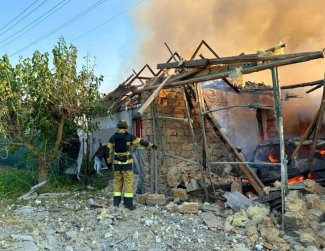Russia’s generals frustrated. Day 505 of the war

Russian forces pushed the Ukrainian defenders out of more positions on the forest massif south-west of Kreminna, an area bounded by the River Donets to the south and the Zherebets river to the west. They also approached the village of Torske located on the Zherebets, through which the main supply route for the Ukrainian units defending themselves on the massif runs from Lyman. The Russians have also made progress on the border of Luhansk and Kharkiv oblasts, taking partial control of Novoselivske and launching an assault towards Stelmakhivka. On the other hand, the Russian attacks towards the Zherebets on the border of Donetsk and Luhansk oblasts appear to have failed. Both Ukrainian and Russian attacks in the Avdiivka and Bakhmut regions were also unsuccessful. Nevertheless, the General Staff of the Ukrainian army reported partial success to the south-west of the latter town (in the direction of Bila Hora and Andriivka).
Ukrainian troops have regained control of the zverinets (so-called ‘animal farm’, a former livestock farm) south-east of Marinka. However, further Russian attacks in the western part of the town and south of it have failed to yield results. A succession of Ukrainian attempts to advance on the border of Zaporizhzhia and Donetsk oblast, south-east of Velyka Novosilka and in Zaporizhzhia oblast, also failed, although the General Staff of the Ukrainian army reported “some success” south of Orikhiv. According to some sources, the Russians carried out a successful offensive operation in the area of Huliaipole, approaching the village of Chervone which lies to the east of it. According to communiqués from the Ukrainian authorities in Mariupol, more Russian units (including naval infantry) have entered the town and its surroundings, and the total number of invading troops assembled there has now reached 35,000.
For three nights in a row the Russians have launched air strikes against Ukraine using Shahed-136/131 kamikaze drones. According to the Ukrainian Air Force Command, on 12 July the defenders shot down 11 out of 15 drones, on 13 July all 20, and on 14 July 16 out of 17. The most serious impact came from the 13 July attack, in which at least four areas of Kyiv were damaged and several people were injured. On the same day Kirovohrad oblast, including its capital Kropyvnytskyi, was also targeted by enemy drones. The day before, more Shaheds destroyed an infrastructure facility in Cherkasy oblast, as well as a factory in Kryvyi Rih on 14 July. A strike from an unidentified object caused damage in Zaporizhzhia on 12 July, where 21 people were injured; Nikopol and its environs were also targeted by a massive artillery barrage. On 13 July, enemy rockets struck Khmelnytskyi oblast; the Air Force Command reported that the invaders used two Kalibr missiles (both of which were shot down) and one Iskander-M missile.
On 12 and 13 July, Mariupol came under Ukrainian missile attack. According to the deputy defence minister Hanna Maliar, over previous days the defenders succeeded in destroying numerous ammunition depots during their attacks on the Russian hinterland in the south, and as a result the amount of hostile shelling has decreased. On the night of 11 July, Ukrainian Storm Shadow missiles also struck a reserve command post of the 58th Combined Arms Army (responsible for defence in Zaporizhzhia oblast) near Berdyansk. The deputy commander of the Southern Military District, General Oleg Tsokov, was killed there.
On 11 July, on the margins of the NATO summit in Vilnius, the 11 countries of the so-called ‘aircraft coalition’ agreed to start training Ukrainian pilots on F-16 fighter jets “at the end of the summer” (most likely in August). The practical pilot training is to take place in Denmark, and a regional training centre will also be set up in Romania. The contributions from individual countries vary: Poland is to offer infrastructure for pilot training, and the UK (which does not use F-16s) will organise basic teaching on training aircraft. Belgium, the Netherlands, Canada, Luxembourg, Norway and Sweden are also participating in the coalition; Dutch defence minister Kajsa Ollongren announced that the training would take six to eight months. On 13 July Jake Sullivan, the national security advisor to the US President, said that Ukraine would receive F-16s from their European users once the training had been completed.
On 11 July French President Emmanuel Macron announced the transfer of “long-range missiles to support the Ukrainian army’s offensive”. Reuters elaborated that these would be 50 SCALP cruise missiles, which have a range of 250 km. Ukrainian defence minister Oleksiy Reznikov also announced the signing of an agreement with the French Defence Ministry, under which Paris’s military aid to Kyiv is to be increased by €170 million, the process of purchasing and supplying armaments will be simplified, and the basis for the joint production of spare parts and servicing armaments & military equipment will be laid. The following day, the government in London announced the delivery of more than 70 combat and logistics vehicles, including combat reconnaissance vehicles, and ammunition for Challenger 2 tanks. The Norwegian defence ministry announced a ‘support package’ consisting of NASAMS air defence systems (two additional fire control stations, two launchers and spare parts), as well as 1000 Black Hornet reconnaissance minidrones. President Volodymyr Zelensky reported on a new support package from Australia, including 30 Bushmaster armoured vehicles, while Reznikov announced the signing of a Ukrainian-Swedish agreement on cooperation in defence procurement. Japanese Prime Minister Fumio Kishida, who was present at the summit, announced the handover of a drone detection system. On 13 July General Oleksandr Tarnavsky, commander of Ukraine’s Tauryda operational-strategic military grouping, confirmed that they had received cluster munitions from the US.
On 13 July, a new batch of military aid was announced on German government websites, fulfilling earlier announcements. It includes six Gepard self-propelled anti-aircraft guns; armoured bridgelayer Biber and an additional bridge for mounting on a tank chassis; 3230 artillery shells and 1184 smoke shells of 155-mm calibre; over 24,000 rounds of 40-mm ammunition; and 10 fire control stations and 10 laser sights for IRIS-T SLM air defence systems. The previous day, the German media reported that Berlin was withdrawing from the plan to set up a joint service and repair centre in Poland for the Leopard 2 tanks which have been handed over to Ukraine. The 2A5 and 2A6 tanks will now be serviced in Germany, and most probably in Lithuania (the PzH 2000 self-propelled howitzers are serviced and repaired there). However, the German defence ministry has announced that Poland and Germany intend to coordinate the overhaul procedure together; it also reported that the discussions on servicing Leopard 2A4s had not yet been concluded.
More reports are emerging about possible purges in the Russian command staff directing the invasion of Ukraine. On 12 July, State Duma deputy Andrey Gurulyov (a former deputy commander of the Southern Military District) issued a recording of 58th Army commander General Ivan Popov stating that he had been dismissed after reporting to the Chief of General Staff about the poor situation on the frontline. He cited the lack of sufficient artillery reconnaissance radars and poor reconnaissance of enemy forces as the biggest problems, which have resulted in huge casualties. He also pointed out that it was necessary to rotate the units of the army under his command.
The Wall Street Journal has confirmed reports circulating in the Russian media space that more military officers who had contacts with Yevgeny Prigozhin have been dismissed from their posts. At least 15 Russian senior officers were said to have been isolated and interrogated by FSB military counterintelligence since the end of the mutiny. Those dismissed include Army General Sergey Surovikin, the deputy commander of Russian troops in Ukraine; Colonel General Andrei Yudin, the deputy commander of the Air and Space Forces; and Lieutenant General Vladimir Alekseev, the deputy head of military intelligence. The former deputy defence minister Lieutenant General Mikhail Mizintsev, who had been working with Prigozhin since April, has also apparently been detained.
On 12 July, the Russian defence ministry announced that the Wagner Group had completed the handover of its weapons and heavy military equipment to the Russian Armed Forces. The communiqué highlighted that the army had taken control over “hundreds of tanks”, Grad and Uragan rocket artillery systems, Pantsyr air defence systems, self-propelled artillery and armoured personnel carriers, as well as more than 2500 tonnes of ammunition and around 20,000 small arms.
On 11 July, the Belarusian defence ministry announced that preparations were being completed at local training grounds to receive another group of Russian and Belarusian soldiers who will undergo joint combat training (according to independent sources, 1240 soldiers were due to arrive from Russia). The last rotation of Russian units forming part of the Regional Grouping of the Russian and Belarusian Forces was carried out over a month ago. The communiqué signalled that in the event of the arrival of “Wagner representatives”, they could be deployed to the training grounds for training and mutual exchanges of experience. On 12 July the commander of the Belarusian interior ministry’s internal troops, Mikalai Karpiankou, confirmed while visiting the Typhoon special unit in Hrodna that negotiations were underway with Wagner troops on organising training. On 14 July, the Belarusian defence ministry’s TV channel VoyenTV aired a short report stating that Vagner Group soldiers had begun training Belarusian Territorial Defence Force troops at the Asipavichy training ground.
On 13 July Lieutenant General Serhiy Nayev, the commander of the Combined Armed Forces of Ukraine, revealed that since the beginning of July 30 anti-tank minefields (5800 mines) had been laid on the border with Belarus, and the engineering barrages and trench lines there had been expanded.
Commentary
- The effect of the so-called Prigozhin rebellion has been to publicise further expressions of the dissatisfaction which the generals feel towards the so-called Special Military Operation (SMO) and how it is being conducted by Russian defence minister Sergei Shoigu and Chief of General Staff of the Russian Armed Forces General Valery Gerasimov, after those which were observed last spring in connection with the Russian army’s withdrawal from the north of Ukraine. Unlike the situation in 2022, however, these voices are not exclusive to former military officers. It remains unclear whether the opinion of the commander of the 58th Combined Arms Army would have been made public had retired General Gurulyov not chosen to do so. However, the criticism of the operation and the military mistakes made during it is now a fact. Its origins can be traced back to the so-called Gerasimov doctrine, published a decade ago, which is simplistically referred to as the Russian doctrine of hybrid warfare. This assumed that military engagement would account for only around ten per cent or so of the total of broadly defined forces and measures (economic, informational etc.) which would be used in a future war. However, it did not foresee a situation in which the adversary – here Ukraine, supported by the Western community – would informationally and economically (and potentially militarily) be in a much stronger position than Russia. The criticism of the SMO therefore does not represent criticism of the war, but rather of the still limited approach which the military leadership and Vladimir Putin have so far displayed towards it. The opponents of Shoigu and Gerasimov have unanimously stated that victory in Ukraine will only be possible with widespread mobilisation and a return to Soviet-era methods of warfare.
- There are strong indications that Prigozhin’s mutiny has led to personnel changes among the senior commanders of the Russian forces fighting in Ukraine. Officers suspected of having close ties with the head of the Wagner Group and sharing his negative opinion of Shoigu and Gerasimov’s qualifications are being removed. General Popov’s statement, on the other hand, is indicative of the growing frustration among the generals directly responsible for conducting combat operations. It is notable for highlighting the shortages of equipment and the General Staff’s disregard for proposals to improve morale, as well as confirming the considerable effectiveness of Ukrainian artillery, which has caused significant casualties.




